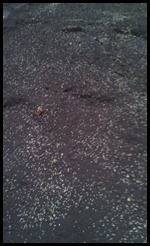Article first published as Book Review: Gathering: Memoir of a Seed Saver by Diane Ott Whealy on Blogcritics.
First, a bit of background on the lens through which I read Gathering: Memoir of a Seed Saver. As a child, I spent a lot of time in the summer working in the garden and often could not wait to be done with it.
Fast forward a number of years, however, and I find myself interested again. The idea of growing your own food is a compelling one for many people, particularly in this age of economic uncertainty. I’m certainly very much in agreement with the goals of this organization and my review reflects that.
When my wife and I started researching various aspects of gardening and sustainability, some resources kept popping up in more than one book and one of them was Seed Savers Exchange. Seed Savers Exchange (SSE) is a non-profit organization with the mission of saving and sharing the richness of genetic and cultural diversity found in open-pollinated seed.
Today many of the seeds you find in the seed rack are hybrid types. But you can’t save hybrid seed year after year; you must buy it again each time. This book is the memoir of Diane Ott Whealy, one half of the husband and wife team that brought SSE to life.
While it certainly helps if you are interested in the subject matter, there are aspects of this book that make it a compelling read for anyone interested in small business, entrepreneurship and the strength of the human spirit.
Diane and her husband Kent fought through many obstacles to bring Seed Savers to where it is today. Ms. Whealy is honest and forthcoming about the very real struggles that it took to develop the organization to where it is today.
When they were getting SSE off the ground, the idea of preserving genetic diversity and using sustainable gardening practices was going through a dark period. For hundreds of years, farmers had basically farmed organically, saving their best seed from year to year.
But starting in the early to mid 1900s, a new rush of “progress” pushed farmers to make production the primary goal, through the use of chemical fertilizers, unsustainable soil practices and the new hybrid seeds and later GMO seeds.
Open pollinated seeds must be regularly planted and saved or they can be lost forever. In addition, the diversity of seeds in catalogs for the home gardener was dwindling. Each year found more and more varieties unaccounted for and some seeds were only available from a single source. The Whealys recognized this as the problem it was and set about trying to do something about it, well before most people were thinking in these terms.
Scattered around the country, there were other individuals with the same dreams and goals. Seeds Savers provided a framework to bring these people together and work for the common good. They started in 1975 with only 29 gardeners exchanging and sharing seed. The tradition was started of a yearly meeting on the property, with like-minded folks coming from all over the country. By 1983, they had around 3500 different seed varieties in their collection, including 2000 different beans, 500 different peppers and 200 different squashes. For the most part, the business was run out of their home and there wasn’t always money for a salary. Income came from the seed catalog they distributed each year.
Another struggle was finding the room to work and grow the business. The Whealys moved around several times before Seed Savers finally found the right property in Decorah Iowa. Eventually Kent Whealy won the MacArthur “Genius” grant in 1990 and there were some other grants along the way. These grants, along with growth in the business and help from other benefactors finally got SSE on stable footing.
Later the organization was also able to purchase an additional 700+ acre property of pasture and woods, giving them a large protected area to carry out their mission. But it was a long road to get there, years of laboring and putting everything back into the organization. This shows the perseverance that is often necessary to make your dreams come true.
This intense, sustained focus on the organization was not without its downsides. It took a toll on the Whealy’s marriage, which ended in divorce in 2004. It is very difficult to pour your entire waking existence into a dream without some aspects of your life being neglected. This is food for thought for any entrepreneur. On the other hand it is often difficult to create something of good and lasting value without a lot of sacrifices along the way. Many people are grateful to the Diane and Kent Whealy for the lasting impact their life work has had and will continue to have on the sustainability and organic gardening movement.


